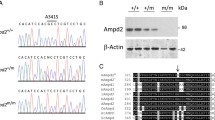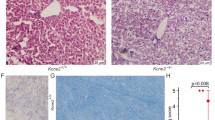Summary
In the current study our objective was to develop a murine model of human hyper-IgD syndrome (HIDS) and severe mevalonic aciduria (MA), autoinflammatory disorders associated with mevalonate kinase deficiency (MKD). Deletion of one Mvk allele (Mvk +/−) yielded viable mice with significantly reduced liver Mvk enzyme activity; multiple matings failed to produce Mvk −/− mice. Cholesterol levels in tissues and blood, and isoprene end-products (ubiquinone, dolichol) in tissues were normal in Mvk +/− mice; conversely, mevalonate concentrations were increased in spleen, heart, and kidney yet normal in brain and liver. While the trend was for higher IgA levels in Mvk +/− sera, IgD levels were significantly increased (9–12-fold) in comparison to Mvk +/+ littermates, in both young (<15 weeks) and older (>15 weeks) mice. Mvk +/− animals manifested increased serum TNF-α as compared to wild-type littermates, but due to wide variation in levels between individual Mvk +/− mice the difference in means was not statistically significant. Mvk +/− mice represent the first animal model of HIDS, and should prove useful for examining pathophysiology associated with this disorder.
Similar content being viewed by others
References
Drenth JP, Haagsma CJ, van der Meer JW (1994) Hyperimmunoglobulinemia D and periodic fever syndrome. The clinical spectrum in a series of 50 patients. International Hyper-IgD Study Group. Medicine 73: 133-44.
Drenth JP, Cuisset L, Grateau G, et al (1999) Mutations in the gene encoding mevalonate kinase cause hyper-IgD and periodic fever syndrome. International Hyper-IgD Study Group. Nat Genet 22: 178-81.
Ghittoni R, Napolitani G, Benati D, et al (2006) Simvastatin inhibits the MHC class II pathway of antigen presentation by impairing Ras superfamily GTPases. Eur J Immunol 36: 2885-893.
Gibson KM, Hoffmann G, Nyhan WL, et al (1988) Mevalonate kinase deficiency in a child with cerebellar ataxia, hypotonia and mevalonic aciduria. Eur J Pediatr 148: 250-52.
Gibson KM, Gupta M, Baetscher M, Steiner RD, Hoffmann GF, Hager EJ (2006) Early embryonic lethality associated with targeted disruption of the murine mevalonate kinase gene. J Inherit Metab Dis 29(Supplement 1): 50 [abstract].
Gibson KM, Tse TE, Pappu AS, Steiner RD, Hoffmann GF, Hager EJ (2007) Chronic inflammation and hyper IgD/IgE in mice with targeted deletion of the mevalonate kinase. (Mvk) gene. J Inherit Metab Dis 30(Supplement 1): 45 [abstract].
Hillyard DZ, Jardine AG, McDonald KJ, Cameron AJ (2004) Fluvastatin inhibits raft dependent Fcgamma receptor signalling in human monocytes. Atherosclerosis 172: 219-28.
Hinson DD, Chambliss KL, Toth MJ, Tanaka RD, Gibson KM (1997) Post-translational regulation of mevalonate kinase by intermediates of the cholesterol and nonsterol isoprene biosynthetic pathways. J Lipid Res 38: 2216-223.
Hoffmann G, Gibson KM, Brandt IK, Bader PI, Wappner RS, Sweetman L (1986) Mevalonic aciduria—an inborn error of cholesterol and nonsterol isoprene biosynthesis. N Engl J Med 314: 1610-614.
Hogema BM, Gupta M, Senephansiri H, et al (2001) Pharmacologic rescue of lethal seizures in mice deficient in succinate semialdehyde dehydrogenase. Nat Genet 29: 212-16.
Houten SM, Frenkel J, Rijkers GT, Wanders RJ, Kuis W, Waterham HR (2002) Temperature dependence of mutant mevalonate kinase activity as a pathogenic factor in hyper-IgD and periodic fever syndrome. Hum Mol Genet 11: 3115-124.
Hubner C, Hoffmann GF, Charpentier C, et al (1993) Decreased plasma ubiquinone-10 concentration in patients with mevalonate kinase deficiency. Pediatr Res 34: 129-33.
Klasen IS, Goertz JH, van de Wiel GA, Weemaes CM, van der Meer JW, Drenth JP (2001) Hyperimmunoglobulin A in the hyperimmunoglobulinemia. D syndrome. Clin Diagn Lab Immunol 8: 58-1.
Mandey SH, Schneiders MS, Koster J, Waterham HR (2006a) Mutational spectrum and genotype-phenotype correlations in mevalonate kinase deficiency. Hum Mutat 27: 796-02.
Mandey SH, Kuijk LM, Frenkel J, Waterham HR (2006b) A role for geranylgeranylation in interleukin-1beta secretion. Arthritis Rheum 54: 3690-695.
Ness GC, Chambers CM (2000) Feedback and hormonal regulation of hepatic 3-hydroxy-3-methylglutaryl coenzyme A reductase: the concept of cholesterol buffering capacity. Proc Soc Exp Biol Med 224: 8-9.
Neven B, Valayannopoulos V, Quartier P, et al (2007) Allogenic bone marrow transplantation in mevalonic aciduria. N Engl J Med 356: 2700-703.
Ohashi K, Osuga J-i, Tozawa R, et al (2003) Early embryonic lethality caused by targeted disruption of the 3-hydroxy-3-methylglutaryl-CoA reductase gene. J Biol Chem 278: 42936-2941.
Okamoto T, Fukunaga Y, Ida Y, Kishi T (1988) Determination of reduced and total ubiquinones in biological materials by liquid chromatography with electrochemical detection. J Chromatogr 430: 11-9.
Pappu AS, Illingworth DR, Bacon S (1989) Reduction in plasma low-density lipoprotein cholesterol and urinary mevalonic acid by lovastatin in patients with heterozygous familial hypercholesterolemia. Metabolism 38: 542-49.
Pappu AS, Connor WE, Merkens LS, et al (2006) Increased nonsterol isoprenoids, dolichol and ubiquinone, in the Smith–Lemli–Opitz syndrome: effects of dietary cholesterol. J Lipid Res 47: 2789-798.
Prietsch V, Mayatepek E, Krastel H, et al (2003) Mevalonate kinase deficiency: enlarging the clinical and biochemical spectrum. Pediatrics 111: 258-61.
Rios SE, Cho YK, Miziorko HM (2001) Characterization of mevalonate kinase V377I, a mutant implicated in defective isoprenoid biosynthesis and HIDS/periodic fever syndrome. Biochim Biophys Acta 1531: 165-68.
Tozawa R-i, Ishibashi S, Osuga J-i, et al (1999) Embryonic lethality and defective neural tube closure in mice lacking squalene synthase. J Biol Chem 274: 30843-0848.
Turpeinen U (1986) Liquid-chromatographic determination of dolichols in urine. Clin Chem 32: 2026-029.
Author information
Authors and Affiliations
Corresponding author
Rights and permissions
About this article
Cite this article
Hager, E.J., Tse, H.M., Piganelli, J.D. et al. Deletion of a single mevalonate kinase (Mvk) allele yields a murine model of hyper-IgD syndrome. J Inherit Metab Dis 30, 888–895 (2007). https://doi.org/10.1007/s10545-007-0776-7
Received:
Revised:
Accepted:
Published:
Issue Date:
DOI: https://doi.org/10.1007/s10545-007-0776-7




